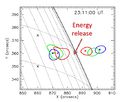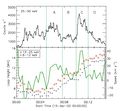RHESSI's Tenth Anniversary
From RHESSI Wiki
Contents |
RHESSI's Scientific Legacy
February 5, 2012, marks the 10the anniversary of RHESSI's launch. At this time, it seems appropriate to review the scientific achievements to date, and here I offer a personal top-ten list of the iconic figures that I think will constitute RHESSI's legacy. A much more comprehensive review of RHESSI's scientific achievements can be found in the recently published Space Science Review (Vol. 159, Issue 1-4) - High-Energy Aspects of Solar Flares: A RHESSI-inspired monograph.
First of all, it is important to remember that RHESSI was designed to combine both X-ray and gamma-ray imaging spectroscopy in a single instrument with the stated goal of investigating particle acceleration and energy release in solar flares. It is natural to breakdown the scientific results into two areas - those relating to the nonthermal electrons producing harder X-ray and gamma-ray continuum emissions, and those relating to the energetic ions that produce gamma-ray emissions. A third area, the hot thermal plasma, has also proved to be productive thanks to the extension of RHESSI's low energy X-ray coverage down to ~3 keV made possible by last minute improvements in the germanium detectors and electronic. I will consider results in these three areas as they reflect the importance in establishing RHESSI's unique contributions to understanding flare energy release and particle acceleration.
Thermal Plasma
Sui and Holman (2003)
The detection of twin X-ray sources in the solar corona with opposite spectral evolution as a function of altitude. This provided the strongest evidence yet for energy release in the corona between the two sources as indicated in Fig. 1
Sui and Holman (2003) also reported the initial downward motion of the coronal X-ray source prior to its previously reported continuous upward motion. This was further detailed by Sui et al. (Sui, Holman, & Dennis 2004, Ap. J., 612, 546), where it was shown (Fig. 2) that the rate of altitude increase correlated with the hard X-ray flux suggesting that it was related toe the energy release rate.
Caspi and Lin (2009?)
The location of a superhot X-ray source in the coronal and a second cooler thermal source lower in the corona.
Nonthermal Electrons
Krucker et al.
The detection of nonthermal hard X-rays from high altitude coronal sources.
Fletcher et al. (2007?)
The detection of multiple footpoint hard X-ray sources and their propagation along flare ribbons.
Accelerated Ions
Hurford et al. (2007?)
The detection of gamma-ray sources at locations different from the locations of X-ray sources.
Smith et al. (2003)
The measurement of Doppler shifts in gamma-ray lines caused by the motion of the emitting ions away from the observer.

